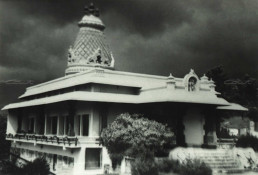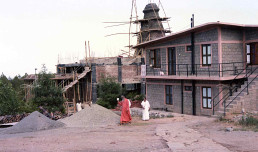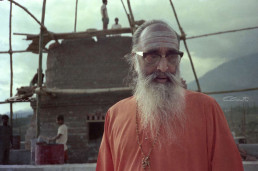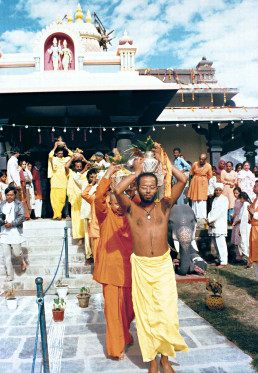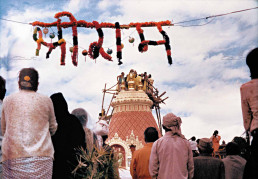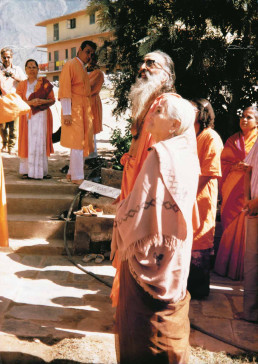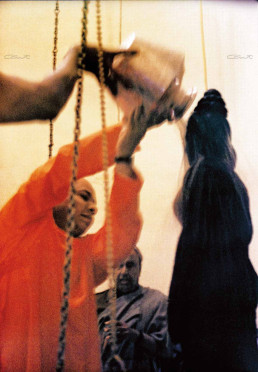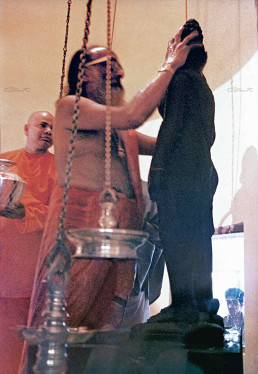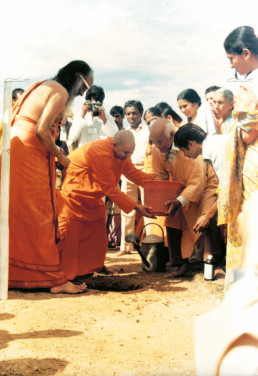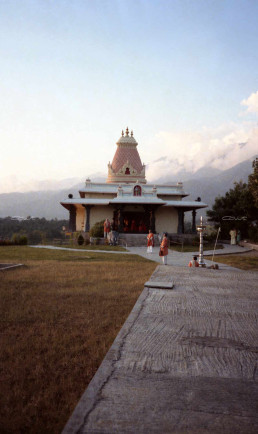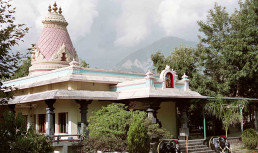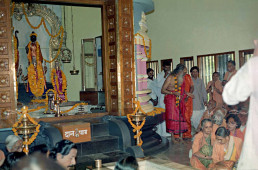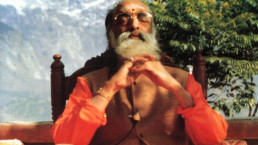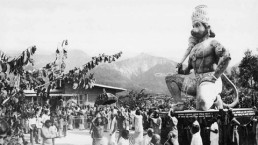The presence of a devotee draws the Lord without fail. Pujya Gurudev carefully planned the location of the Ram Mandir such that the eyes of Sidhbari Veera Hanumanji could forever gaze at the Lotus Feet of Bhagavan Rama.

The first Hanuman Mastakabhishekam completed on Oct.10th, 1982, showered the funds to lay the foundation for a unique temple – the first temple for Sri Rama and His Consort Sita in the Himachal land where, though Tulsi Ramayana was revered, most temples were for Devi or Shakti.
On March 6th, 1983, during the Bhoomi puja, Pujya Gurudev remarked that the temple would be a Setu, bridging the cultures of North and South. And, the idols to adorn the temple were Vanavaasi Rama and Sita – their austerely beautiful forms during their exiled 14-year forest life. The idols were carved from soft black stone by a famous sculptor Sri B. Basavanna of Mysore.
While explaining the significance of the Vedic rituals after the Bhoomi Puja, as the divine idols of Sri Rama and Maata Sita were unveiled, Pujya Gurudev, with His typical humour, pointed out that “Lakshmana had gone to collect fruits!” Maybe Pujya Gurudev wanted us to remember that Lakshmana-like Vairagya must be in our hearts in a life of Tapas and Bhakti.
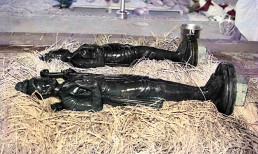
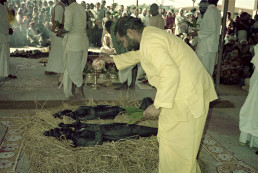
The Dhaanya Adhivaasa ritual on March 6th, 1983, was highly significant. The exquisite idols of Sri Rama Sita gracefully placed on a bed of grains to await installation were a heavenly sight. When people offered grains and even silver coins to the idols, Pujya Gurudev emphasized the importance of surrender, both spiritual and material.
A rare aspect of the Vanavaasi Ram Mandir is how the main altar of the temple is truly and literally founded on intense worldwide prayers. In response to Gurudev’s call for a Likhita Japa Yajna, 7844 devotees from 24 countries wrote “Om Sri Ram Jaya Ram Jaya Jaya Ram.” The total count of the written Japa was 28,84,875 when they were reverentially placed in the enclosure below the inner shrine.
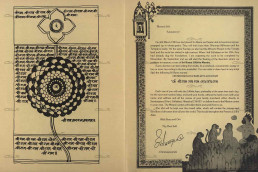
Pujya Gurudev carefully planned the location of the Ramaalaya such that the eyes of Sidhbari Veera Hanumanji could forever rest at the Lotus Feet of His beloved Lord Rama. And, Pujya Gurudev emphasized how the ‘Kurma’ placed in the threshold of Sri Ram Mandir reminds devotees to withdraw all wandering senses for a fulfilling darshan of Bhagavan Rama.
The Mandir construction was completed in a record six months. Pujya Gurudev once remarked that “Hanumanji Himself was literally building the temple!” The entire Mandir is an aesthetic masterpiece of sacred beauty and symbolism.
In the video excerpts below, Sri Hemachandrudu of Lakshmi Constructions, Chennai, recalls the large-hearted love of Pujya Gurudev when credits were given for the temple construction.
The Kumbhabhishekam of the Vanavaasi Ram Mandir was a momentous three-day celebration with notable events. Oct.21st, 1983, began with Pujya Gurudev initiating a great blessing to Chinmaya Mission’s future. In a special diksha ceremony, Brni Yamuna Devi became Swamini Gangananda and Br. Radhakrishnan became Swami Jyotirmayananda. Br. Vivek Chaitanya, the first acharya of Sandeepany Himalayas was given sannyasa diksha to become the beloved Pujya Guruji Swami Tejomayananda, the global head of Chinmaya Mission from 1993 to 2016.
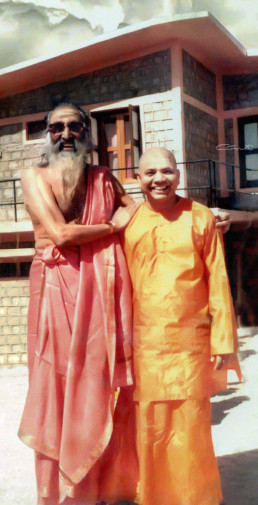
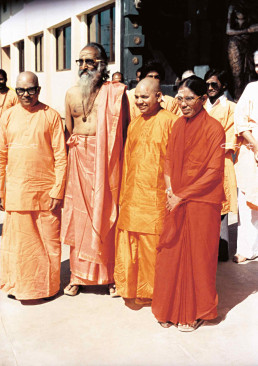
The whole atmosphere of Chinmaya Tapovan ashram was surcharged with spiritual vibrations on Oct.22nd when the newly initiated Swamis performed Kumbhabhishekam amid akhanda chanting of “Om Rama Ramaya Namah,” preliminary homa, pujas, archanas, and a Kalasha procession – all conducted flawlessly in Vedic style which filled the hearts of everyone.
Later on, when Pujya Gurudev performed Prana Pratishta to invoke Bhagavan’s Presence in the idols within the temple, the faces of Vanavaasi Rama Sita shone with a divine glow.
The consecration continued on Oct.23rd with the installation of Lord Ganesha and the Utsava Murtis – the idols of Ram Parivar.
Rare is the opportunity to witness a temple’s consecration. The devotees in Sidhbari, from the Governor of Himachal Pradesh to the simple Pahadi villager, were overjoyed by the grand celebrations of the Maha Kumbhabhisekham.
Today, as we prostrate inside that incomparable Vanavaasi Ram Sita Mandir in Sidhbari, we realize that here is an auspicious sanctum where Pujya Gurudev showed us the joy of penance, purity, deep faith, and devoted work.
From Veera Hanuman to Sri Ram - A panoramic view
Ram Mandir Videos
A glimpse of the Likhita Japa books which were later placed under the altar
Pujya Gurudev does Prana Pratishta for the newly installed idols.
Navigation
Next Topic
Spiritual Camps
Sidhbari is synonymous with Pujya Gurudev’s unforgettable spiritual camps. He would say: "It is absolutely necessary for spiritual Sadhaks to dry-dock to a…
Home Page
Sidhbari Ashram
Chinmaya Tapovan ashram in Sidhbari shines as the crest-jewel of Chinmaya Mission where the Grace of the Guru awakens the thirst for Knowledge ripened with devotion.
Previous Topic
Veera Hanuman
Vayuputra Shri Hanuman is a powerful presence in the Chinmaya ashram at Sidhbari; awe-inspiring, alert, and magnificent. Pujya Gurudev invoked Veera Hanuman in…

